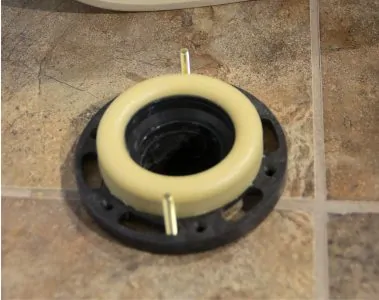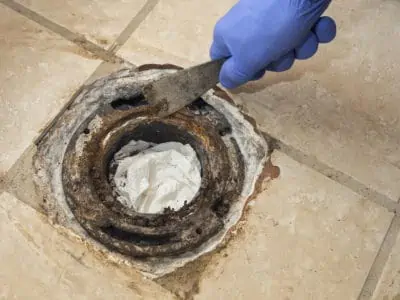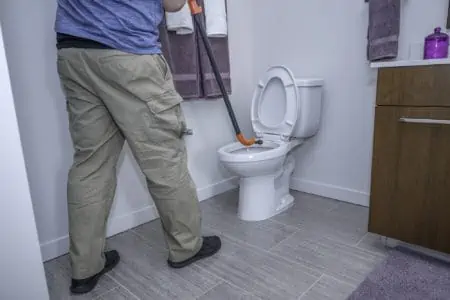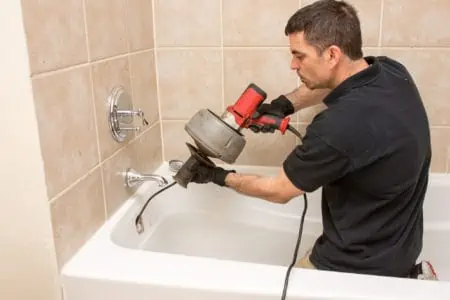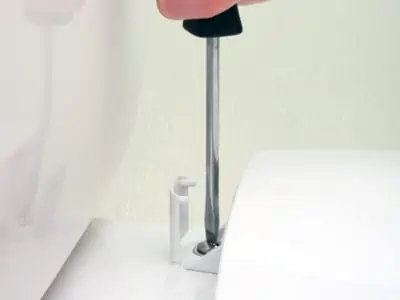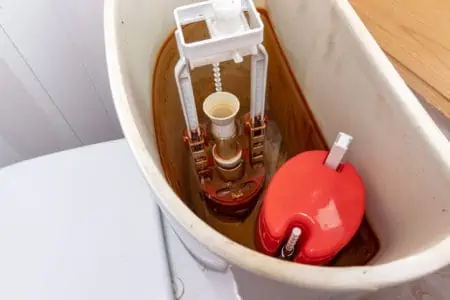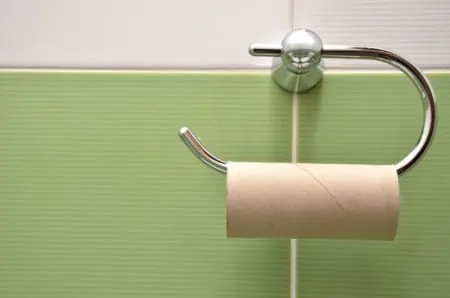If you can smell sewage in your bathroom or water is leaking from around the toilet bowl, you might need to replace your toilet flange. This small piece of hardware under your toilet plays an important role in ensuring it works properly.
As the flange isn’t normally visible, you might not be aware of this part until it goes wrong and you notice leaks or odors. Many types of flanges are available, so you might need some guidance to find the right model for your home.
To help you find a suitable product for your bathroom, we have reviewed five of the best toilet flanges that are currently available. We chose these flanges based on their type, size, and material to ensure your toilet will be watertight again.
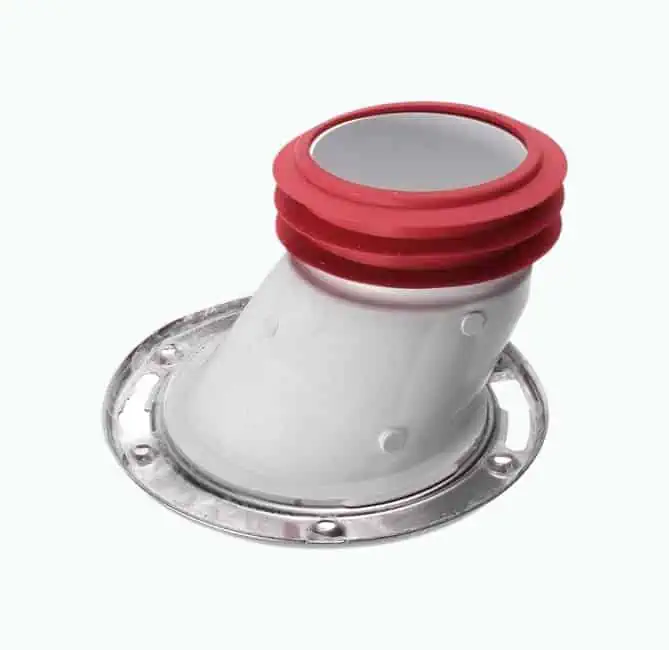
- Moves the drain 1.5 inches away
- Stainless steel swivel ring
- Thick elastomer rubber band
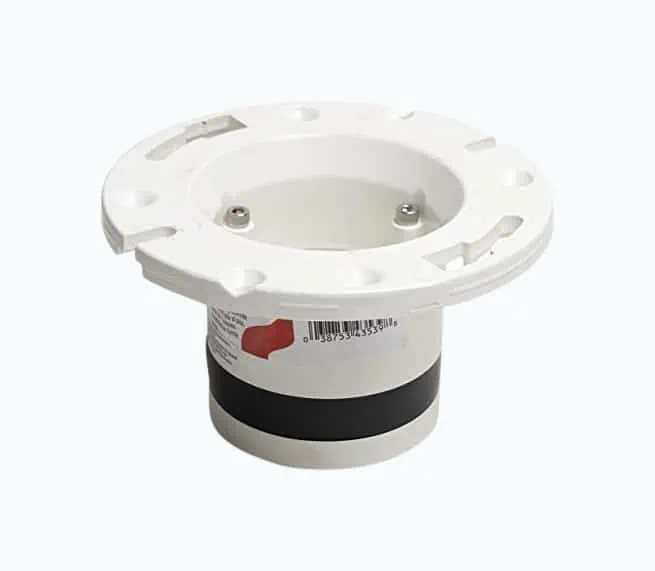
- Includes bolts
- One-year warranty
- Lightweight
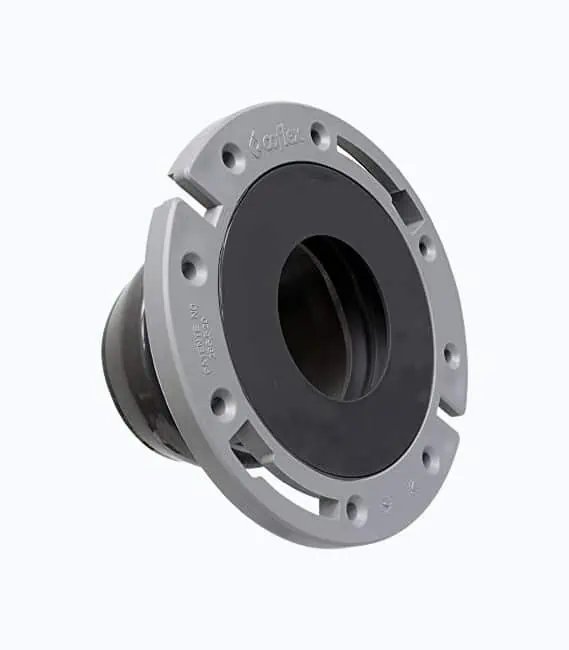
- Two spacers included
- Can be installed inside an old flange
- Wax ring isn’t required
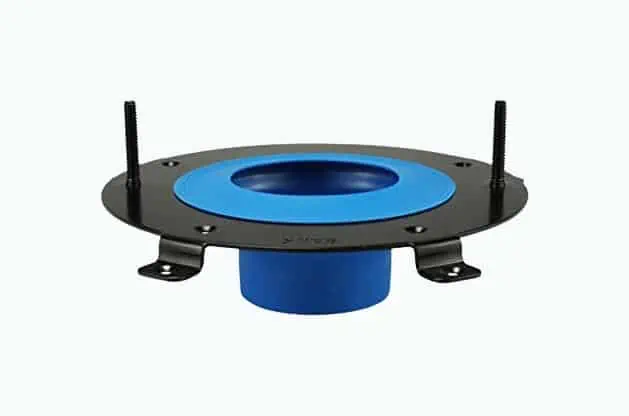
- Easy to install
- Old flange doesn’t need to be removed
- Includes screws and washers
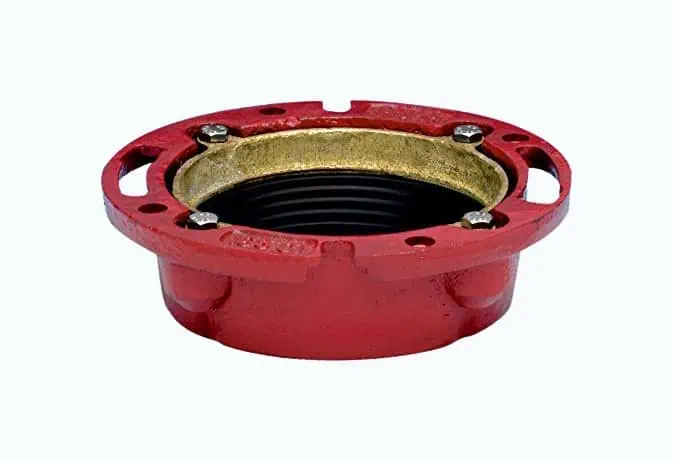
- High-quality cast iron and brass
- One-year warranty
- Thick edges
Review Methodology: At Sensible Digs, we take pride in delivering accurate, experience-based evaluations of the best toilet flanges. Our team conducts extensive research, carries out hands-on tests, and uses data from our findings to rank each product based on performance, design, and key decision-making factors. Our professional assessment includes comparing products and scoring them on critical benchmarks such as durability, ease of installation, and materials used. We provide you with the facts, backed by evidence, so you can make an informed decision. Trust in our reviews and choose the toilet flange that best suits your needs.
The Best Toilet Flanges of 2024
Choosing the best toilet flange from the numerous available options can be intimidating. To make the process easier, we have closely examined many products to review five of the best toilet flanges you can buy today. We did this by looking at their shape, quality, and material, as well as reading feedback from customers.
SIOUX 889-GPOM
Best Offset Toilet Flange
If your drain opening isn’t in an ideal place, this SIOUX offset flange might be the solution. It has a PVC body that features a slight elbow. This design allows you to move the toilet about 1.5 inches from the drain.
The flange is designed for 4-inch pipes and has a top ring made of sturdy 430 stainless steel, so you shouldn’t have to worry about corrosion or rust. This ring can also twist, which makes it easier to install the toilet bowl properly.
Near the bottom of the flange, there is a 1.25-inch rubber band to ensure a tight fit inside the drain. It is made of elastomer rubber, which can withstand contact with chemical compounds (1).
Pros
- Allows for installation 1.5 inches from the drain opening
- Stainless steel swivel ring
- Thick elastomer rubber band
Cons
- Doesn’t include screws or bolts
Product Specs
| Flange Type | Offset stainless steel flange |
| Pipe Dimensions | 4 inches |
| Material | PVC and stainless steel |
| Dimensions | 4 by 3 by 3 inches |
| Unique Feature | Offset type |
Our Ratings
User Experience
Oatey GIDDS-173390 43539 Replacement Flange
Most Popular Toilet Flange
This Oatey toilet flange is designed to fit 4-inch pipes. It is made of PVC plastic, so it won’t suffer corrosion as a metal flange would. If you currently have a cast-iron flange, this product should be an ideal replacement. It will fit cast-iron pipes but will also be suitable for other drain materials.
It features a rubber band that holds it tightly in the pipe. Some users are even able to insert this replacement flange inside their existing flange without removing it.
Reviewers praise how user-friendly the flange is and you should be able to install it without professional assistance. Although it is made of plastic, it is high-quality and durable. It also includes 3-inch stainless steel bolts for quick, easy installation.
Pros
- Includes bolts
- 12-month warranty
- Lightweight
Cons
- May not be as tough as expected
Product Specs
| Flange Type | Plastic Flange |
| Pipe Dimensions | 4 inches |
| Material | PVC |
| Dimensions | 12.7 by 7.5 by 4.9 inches |
| Unique Feature | Suitable for cast-iron pipes |
Our Ratings
Personal Perspective
Flexon Toilet Flange with Spacer System
Best Toilet Flange for High Subfloors
This Flexon flange can be used when installing a new toilet or replacing an existing flange. If your floor is higher than the pipe opening, this product should make up the difference. It features spacers that can raise your flange by between 0.12 and 0.37 inches.
An uneven flange can result in an unstable toilet, and the flange can potentially break under pressure. This flange includes a toilet seal gauge, a tool that allows you to check that it is perfectly flat and stable before you continue the installation.
Finally, this model complies with NSF plumbing regulations. This is a sign that its performance, quality, and safety are all of a high standard.
Pros
- Two spacers are included
- Can be installed inside an existing flange
- Includes a gauge
- No wax ring is required
Cons
- Without a wax ring, this product might not be fully air-tight, allowing odors out
Product Specs
| Flange Type | Plastic flange |
| Pipe Dimensions | 4 inches |
| Material | Plastic |
| Dimensions | 11.3 by 6.7 by 4.2 inches |
| Unique Feature | Comes with spacers |
Our Ratings
Community Feedback
Next By Danco (10672X) HydroSeat Toilet Flange
Most User-Friendly Toilet Flange
Removing an old flange can be difficult and time-consuming, and there is also a danger of damaging the drain pipe. Thankfully, this model is designed for quick fixes, so you should be able to do it without assistance even if you aren’t a confident plumber.
This product allows you to fix your leaking toilet without touching your current flange. It is compatible with all old drains and flanges, so it is a safe option for updating your drain setup.
Position a wax ring above the existing hardware and place this new flange onto it. Press firmly and secure it to the floor using the two included steel screws. There are also two stainless steel washers to protect the flange and make it more stable.
Pros
- Easy to install
- Suitable for any old flanges
- Includes stainless steel screws and washers
Cons
- Not suitable for new toilets
Product Specs
| Flange Type | Stainless steel flange |
| Pipe Dimensions | All |
| Material | Rubber funnel, stainless steel frame |
| Dimensions | 7 by 1 by 7 inches |
| Unique Feature | Designed to be installed above an old flange |
Our Ratings
First-Hand Impression
Oatey 42255 Closet Flange, 4-Inch, Cast Iron
Most Durable Toilet Flange
This toilet flange is made using multiple high-quality, durable components. Its body is made of cast iron and it has an inner brass ring. Both materials are hard-wearing and water-resistant, so you can count on this product’s durability.
Near the bottom of the inner ring, there is a rubber band to keep the hardware secured inside the drain pipe. Many reviewers used this model to replace an old cast-iron flange and were very pleased with the results. It is also protected by a 12-month warranty.
Despite being a heavy-duty model, reviewers found it easy to install and most were able to do it without assistance. The only potential issue is that the edges are thick and you may need to drill further into the flooring to accommodate them. You will also need to find your own screws or bolts as they are not included.
Pros
- High-quality materials
- 12-month warranty
- Easy to install
Cons
- Not suitable for high floors
- Doesn’t include screws or bolts
Product Specs
| Flange Type | Cast-iron flange |
| Pipe Dimensions | 4 inches |
| Material | Cast-iron |
| Dimensions | 7 by 7 by 2 inches |
| Unique Feature | High-quality materials |
Our Ratings
User Experience
| Product | Best | Type | Pipe Dimensions | Material | Dimensions | Unique Feature |
|---|---|---|---|---|---|---|
| SIOUX 889-GPOM | Offset | Stainless steel | 4″ | PVC and stainless steel | 4 x 3 x 3″ | Offset type |
| Oatey GIDDS Replacement Flange | Popular | Plastic | 4″ | PVC | 12.7 x 7.5 x 4.9″ | Suitable for cast-iron pipes |
| Flexon Toilet Flange | High Subfloors | Plastic | 4″ | Plastic | 11.3 x 6.7 x 4.2″ | Comes with spacers |
| Next By Danco HydroSeat | User-Friendly | Stainless steel | All | Rubber funnel, stainless steel frame | 7 x 1 x 7″ | Designed – be installed above an old flange |
| Oatey 42255 Closet Flange | Durable | Cast-iron | 4″ | Cast-iron | 7 x 7 x 2″ | High-quality materials |
What Is a Toilet Flange?
A toilet flange is a round object placed over the opening of your toilet’s drain, between the floor and your toilet bowl. Professionals usually refer to it as a “closet flange”.
When you flush your toilet, water flows from the bowl and through a wax ring before reaching the flange. After passing through the flange, it enters your drain pipe to leave your home.
Installing an appropriate flange will not only prevent your toilet from leaking but will also hold your toilet bowl in place more securely, so it is well worth taking the extra time to find the right model.
Types of Toilet Flanges
There are countless toilet flanges available, but they are usually sorted into six broad categories. Familiarizing yourself with the different types of toilet flanges will help you find your ideal model.
Plastic Toilet Flanges
Plastic flanges are the most affordable models and are usually made of polyvinyl chloride — PVC. PVC is a strong, durable, lightweight, and rust-resistant material (2).
Some plastic flanges are made using ABS plastic, which is even stronger and can reduce the noise of water running through.
You will see flanges made entirely of plastic, while some others have a metal ring at the top.
Pros
- Affordable
- Durable and rust-resistant
- Lightweight
Cons
- More likely to crack under high pressure than other materials
Copper Toilet Flanges
Copper flanges are highly resistant to rust and other corrosion. They can be made of flexible copper but might have a more rigid frame. These sturdier models are more durable but also more difficult to install.
Copper also discourages the growth of bacteria, viruses, and fungi. This makes it an ideal choice to channel dirty water from your toilet.
Pros
- Highly resistant to corrosion
- Antibacterial and antifungal
- Can be rigid or flexible
Cons
- Heavier than plastic
Cast Iron Toilet Flanges
This type of flange is typically designed to match cast iron pipes of the same material and usually has an elongated shape. This provides excellent stability as it reaches further down into your drain pipe.
Although cast iron flanges are more expensive, they are also very durable and resistant to corrosion. However, it is important to keep in mind that many different types of cast iron exist with different compositions, so they can vary greatly in quality (3).
Pros
- Sturdy and durable
- Resistant to abrasion and corrosion
- Elongated shape
Cons
- Heavy
- Could rust faster than other materials
Aluminum Toilet Flanges
Despite the name, in most cases, only the ring is made of aluminum, with a body of another material such as plastic or even cast iron. Aluminum is a flexible material, so it is often combined with copper or magnesium to enhance its strength.
Aluminum flanges are long-lasting and will withstand rust and corrosion.
Pros
- Rust-resistant
- Lightweight
- Sturdy when combined with other metals
Cons
- Low-quality aluminum is too flexible to withstand high pressure
Stainless Steel Toilet Flanges
As with aluminum, only the ring is typically made of stainless steel. The rest of the flange is usually cast iron, plastic, or another material.
Keep in mind that there are more than 100 types of stainless steel. 304 stainless steel is the most commonly used type and contains 8% nickel and 18% chromium. Silicone can also be added to improve its resistance to oxidation.
Pros
- Lightweight
- Heat resistant
- Added silicone is resistant to oxidation
Cons
- Stainless steel can vary greatly in quality
Brass Toilet Flanges
Brass flanges are built to last. They are made using copper and zinc alloy for excellent strength and resistance. They are available in various shapes and sizes, including offset types.
The material can withstand water contact and heat, making it a reliable option for a long-lasting flange.
Pros
- Available in various shapes
- Strong and long-lasting
- Corrosion-resistant
Cons
- Heavy
- Can oxidize quickly when exposed to air
Finding the Best Toilet Flanges
When looking for a toilet flange, there is no one size fits all solution. Aside from the materials, they are also available in various shapes, sizes, and thicknesses. Each one is designed to fit different types of pipes and plumbing setups.
Common Toilet Flange Problems
If you have noticed leaks under your toilet, it doesn’t feel stable or is there an unpleasant smell, your flange might need to be replaced. There are some common issues that affect flanges, so one of these might be causing the problem.
Rust and Corrosion
Rust and corrosion are among the leading causes of flange failure. Even the most durable metals can eventually be eaten away by rust, giving the flange a familiar orange color. Check the flange for signs of oxidation as you might need to replace it.
Flange Below Floor Level
A toilet flange should rise just above the floor. If it is below floor level, it won’t be able to hold the toilet properly. The bowl could shift when you sit on it, causing leaks and making your toilet unstable.
If your flange is too low, you have two options. You can either replace it with a higher model or add an extender or spacers. These additional pieces will raise the flange to be above the floor level so it can be used effectively.
Uneven Installation
Your flange should not only be installed above the floor, but all its edges should also be flush with the ground. If there is a gap between the flange and the floor, the pressure could damage its material and even break it if the flange is plastic.
Clogged Pipe
The higher end of the pipe can get clogged with toilet paper or other waste. This means the water will have no way out and will get backed up. If it can’t get through the flange, it might leak out of the sides.
If this occurs, the drain will need to be unclogged, whether you do it yourself or hire a professional. The flange won’t always need to be replaced but it is important to check its condition. If it leaks when the drain is blocked, it might also happen during everyday use.
Other Common Problems
- Rocking toilet: If your toilet isn’t secure, it could rock back and forth when you sit on it. This movement can stress the flange, bending or eventually breaking it. Ensure that the toilet’s bolts are tightened and the bowl is well secured.
- Damaged wax ring: The wax ring is an important layer between your toilet and the flange. It can also be worn down or damaged, allowing water and odors to leak out. This can be easily fixed as you will only need to replace the ring, so you should be able to keep the rest of your flange.
How to Replace a Toilet Flange
If you don’t want to spend money on a professional plumber, you should be able to replace a toilet flange easily using basic DIY tools.
Preparation
- Shut off water: Turn off the water valve that supplies your toilet, or your entire home if you want to be certain.
- Empty the toilet bowl and tank: You can do this by flushing, then using a scoop or a water vacuum.
- Remove the toilet: Unscrew the toilet bolts and lift the toilet. You might need help as a toilet can weigh up to 120 pounds.
- Remove the wax ring: Remove the soft wax ring. If it doesn’t come away in one piece, scrub the remaining wax to remove it.
Remove the Old Flange
- Break off the damaged flange: Once the wax ring is removed, grab a small hammer and chisel. Break the flange from the inside and edges. Sturdier models might require a drill and some extra effort.
- Pull the old flange: Once the flange is loose, use a pry bar to lift it away.
Caution
Installing the New Flange
- Place the new flange: Ensure your new flange will fit properly and sits evenly throughout. You may need to do some extra preparation if the flange doesn’t sit right.
- Optional: Some models require an extra layer of glue to be applied to the outside of the flange before inserting it into the pipe. This will prevent it from shifting after installation.
- Secure the flange: Screw the flange to the floor. Many flanges will include screws or bolts but you might need to buy them separately.
- Insert the toilet bolts: Insert the two screws upside down on each side of the flange. They should be symmetrical and aligned parallel to the back wall.
- Place a new wax ring: No mounting is required; simply place the wax ring above the flange. Many new “wax rings” are actually made of rubber and fit inside the toilet bolts.
Placing the Toilet Back
- Place the toilet: Align the toilet with the bolts in the flange.
- Tighten the bolts: Tightening the bolts will secure the toilet in place.
- Place the caps over the bolts: If the bolts are too long, you can use a tool to cut them to the required length.
- Open the water valve: Open the water supply to the toilet again.
- Test it: Flush the toilet to ensure everything is working properly.
